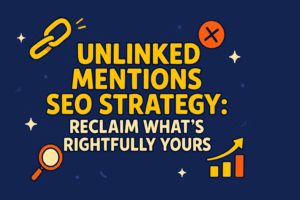
Link building is one of the most important aspects of SEO. We all have heard about links and the role they play in SEO. But there’s a new kid on the block; his name is contextual link building.
Contextual link building is earning links on websites relevant to your own.
This comprehensive guide will discuss contextual links, contextual link buildings, and the difference between contextual and other link-building strategies.
We will also provide five best practices for contextual link-building and eight contextual link-building strategies you can use to get started! Finally, we will answer some frequently asked questions about contextual links.
So, Let’s get started.
What Are Contextual Links?

Contextual links point to your website from within another website’s content. For a link to be contextual, it must be placed within the body of the text and not in the sidebars, footers, or other places on the page.
Contextual links are essential because they help search engines understand your website and its relevance to the searched keywords.
In addition, contextual links are more valuable than other links because they are less likely to be considered spam by search engines. This is because contextual links occur naturally as part of the content on a page, whereas other types of links (such as those in the sidebars or footers) are often added solely for link building.
What Is Contextual Link Building?

Contextual link building is earning contextual links on websites relevant to your own.
The goal of contextual link building is to earn links from websites discussing topics related to your own. This way, when someone reads the content on that website and clicks on your link, they are more likely to be interested in what you offer.
There are many ways to build contextual links; we will discuss them later in this blog. But first, let’s understand the difference between the links.
Difference Between Contextual Links Building And Other Link-Building Strategies
The main difference between contextual link building and other types of links is the type of earned links.
With contextual link building, you earn links within the body of text on another website. These links are more valuable than other types because they are less likely to be considered spam.
Other types of link building, such as link buying or blog commenting, often result in less valuable links and can even be considered spam by search engines.
For this reason, contextual link building is a more sustainable and effective long-term strategy than other types of link building. Let’s move on to some best practices for contextual link building.
Things To Consider Before Contextual Link Building
Before you start contextual link building, you must consider a few things.
- Website Relevancy
You must ensure your website is relevant to the websites from which you want to earn links. For example, if your website is about cats and you’re trying to earn links from a website about dogs, it will not be very effective.
- High-Quality Content
Your website’s content must be high-quality and informative. If you’re trying to earn links from websites with high-quality content, but your content is not up to par, it will be challenging to succeed.
- Keywords (Anchor Text)
Consider the keywords you want to rank for. When contextual link building, you can control the anchor text used.
Anchor text is hyperlinked words, typically underlined and a different color from the rest of the text. Your anchor text should be relevant to the keywords you want to rank for.
For example, if you want to rank for the keyword “cats,” your anchor text could be “feline friends” or “cute cats.” If you’re unsure what keywords to target, research with a tool like Google AdWords Keyword Planner.
- Link Placement
When contextual link building, you also have the opportunity to control where your links are placed. You should ensure that your links are placed in the body of the text and not in the sidebars or footers.
Search engines find links in the sidebars or footers less likely to be clicked on and more likely to be considered spam.
Finally, you need to consider your budget. Contextual link building can be time-consuming, so you must ensure you have the resources to devote to it.
Now that we know what things to consider for contextual link-building. Let’s move on to some contextual link-building strategies.
Eight Contextual Link-Building Strategies
There are several contextual link-building strategies you can use to earn contextual links. Here are the most effective ones:
- Guest Blogging
Guest blogging is a great way to build contextual links. When guest blogging, you write a blog post for another website in your industry. This is a great way to get your name and website in front of new people and also a great way to show your expertise.
This method allows you to choose what you want to write about; you can select your keywords and ensure they are relevant to your website. It also allows you to include a link to your website in your author bio or somewhere in the body of the content with your chosen anchor text.
How do you find guest blogging opportunities?
To find guest blogging opportunities, you can use Google search operators. For example, if you want to write a guest blog post about “contextual link building,” you can search for:
- “guest post” + contextual link building
- “write for us” + contextual linkbuilding
- “contribute” + contextual link building, etc.
- Broken Link Building
Broken link building is where you reach out to websites with broken links and offer to replace the broken link with a working one. This is a great way to build contextual links because it provides value to the website owner by fixing a broken link on their website.
It also allows you to choose your keyword (anchor text) and ensure that the link is placed in the body of the text.
How to find broken links?
You can use a paid tool like ahrefs or a free tool like Google Search Console to find broken links. For example, if you want to find websites with broken links about “relevant content link building,” you can search for:
- “broken link” + relevant content link building
- “dead link” + relevant content link building
- “find dead links” + relevant content link building
- Resource Page Linking
Resource page linking is where you reach out to websites with a resource page and offer to add your website as a resource. This is a great way to build contextual links because it allows you to choose your keyword (anchor text) and ensure that the link is placed in the body of the text.
How to find resource pages?
To find resource pages, you can use paid and free tools. For paid tools, you can use Ahrefs, SEMrush, etc.; for the free tool, you can use Google search operators. For example, if you want to find websites that have a resource page about “relevant content link building,” you can search for:
- “resource page” + relevant content link building
- “link roundup” + relevant content link building
- “useful links” + relevant content link building
- Competitor Backlink Analysis
Competitor backlink analysis involves analyzing your competitors’ backlinks and trying to replicate their success. This is a great way to build contextual links because it lets you see what websites link to your competitors and then contact those websites.
How to do a competitor backlink analysis?
To do a competitor backlink analysis, you can use a paid tool like ahrefs, SEMrush, etc. Both the paid tools have free and paid versions. To use these paid tools, you need to enter your competitor’s website URL, which will show you all the websites linking to them.
Influencer outreach involves reaching out to people with a large social media following or website traffic and asking them to promote your content. This method gets your content in front of a larger audience.
How do you find influencers?
You can use both paid and free tools to find influencers. For example, if you want to find influencers in the SEO industry, you can use BuzzSumo or Followerwonk.
You can also search for specific keywords on Twitter, Google+, etc., and look for people with a large following.
Link bait is content created solely to generate links. The most common types of link bait are infographics, listicles, and quizzes. Link bait can be time-consuming, but it can effectively generate high-quality contextual links.
How to create link bait?
To create link bait, you need to create high-quality content that is more interesting, informative, or entertaining than the content, i.e., ranking on the search engine. You must also ensure your content is shareable by adding social sharing buttons.
- Content Repurposing
Content repurposing is where you update an old piece of content with new information.
How do you repurpose content?
To repurpose content, you must take an old piece of content and add new information or data. You can also update the design or format of the content.
For example, if you have an old blog post about “contextual link building,” you can update it with new information or data and then share it on social media or ask people who have linked to the old post to link to the new post. This can generate more traffic to the website.
- Blogger Reviews
This Technique was prevalent a few years ago, but it is still an effective way to get contextual links. The process is simple: you reach out to bloggers in your niche and ask them to write a review of your product or service. You offer them a link to their website in exchange for the review.
This technique works best if you have a new product or service that many have not reviewed.
To find bloggers who might be interested in writing a review, you can use Google search operators. For example, if you want to find bloggers who write about “relevant content link building,” you can search for:
- “product review” + contextual linkbuilding
- “service review” + contextual linkbuilding
- “guest post” + contextual linkbuilding
This will give you a list of bloggers who write about contextual linkbuilding and are open to writing product or service reviews.
FAQs
Q1. How Many Contextual Links Should I Earn?
Ans. The number of contextual links you should aim for depends on the competition of your niche. If you’re in a highly competitive niche, you should aim for more contextual links than those in a less competitive niche. Contextual link building services can help.
Q2. How Can I Check Whether My Contextual Link-Building Efforts Are Working?
Ans. You can check whether your contextual link-building efforts are working using Google Analytics. Go to Acquisition > All Traffic > Channels and look for increased referral traffic from the websites where you’ve built contextual links.
Q3. Do Contextual Links Help My Website’s SEO?
Ans. Contextual links are among the many factors that Google considers when ranking websites. So, yes, contextual links help your website’s SEO.
Conclusion
You might know contextual link-building and how it differs from other link-building strategies. Contextual link building is an effective way to get high-quality links but can be time-consuming.
You need to consider many factors before starting a contextual link-building campaign, such as the competition of your niche, the quality of your content, etc.
If you have questions about contextual link building, please ask in the comments section below. We would be happy to answer them.
Thank you for reading! I hope this guide was helpful. 🙂


